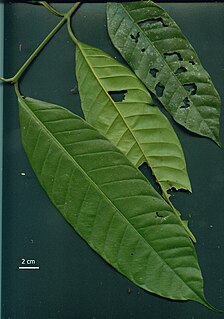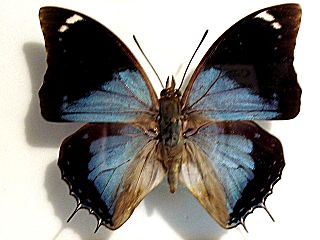
The greater scaup, just scaup in Europe or, colloquially, "bluebill" in North America, is a mid-sized diving duck, larger than the closely related lesser scaup. It spends the summer months breeding in Alaska, northern Canada, Siberia, and the northernmost reaches of Europe. During the winter, it migrates south to the coasts of North America, Europe, and Japan.

Baer's pochard is a diving duck found in eastern Asia. It breeds in southeast Russia and northeast China, migrating in winter to southern China, Vietnam, Japan, and India. The name commemorates the Estonian naturalist Karl Ernst von Baer.

Marila is a plant genus in the family Calophyllaceae. The genus comprises about 20 species, occurring in the Neotropics from Mexico and the Antilles to Bolivia.
Marila saramaccana is a species of flowering plant in the Calophyllaceae family. It is found only in Suriname.
Beauprea congesta is a species of plant in the family Proteaceae. It is endemic to New Caledonia.
Beauprea crassifolia is a species of plant in the family Proteaceae. It is endemic to New Caledonia.

Helicia is a genus of 110 species of trees and shrubs, constituting part of the plant family Proteaceae. They grow naturally in rainforests throughout tropical South and Southeast Asia, including India, Sri Lanka, Indochina, Peninsular Malaysia to New Guinea and as far south as New South Wales.
Helicia albiflora is a species of plant in the family Proteaceae. It is endemic to Papua New Guinea. It is threatened by habitat loss.
Helicia amplifolia is a species of plant in the family Proteaceae. It is endemic to Papua New Guinea. It is threatened by habitat loss.
Helicia insularis is a species of plant in the family Proteaceae. It is endemic to Papua New Guinea. It is threatened by habitat loss.
Helicia latifolia is a species of plant in the family Proteaceae. It is endemic to Papua New Guinea. It is threatened by habitat loss.
Helicia neglecta is a species of plant in the family Proteaceae. It is endemic to Papua New Guinea. It is threatened by habitat loss.
Heliciopsis rufidula is a species of plant in the family Proteaceae. It is a tree found in Peninsular Malaysia and Borneo. It is threatened by habitat loss.
Heliciopsis whitmorei is a species of plant in the family Proteaceae. It is a tree endemic to Peninsular Malaysia. It is threatened by habitat loss.
Leucadendron nobile is a species of plant in the family Proteaceae. It is endemic to South Africa.
Roupala pinnata is a species of plant in the family Proteaceae. It is endemic to Peru.

Bordj Douis or Douis is a small town and commune in Djelfa Province, Algeria. According to the 1998 census it has a population of 10,356. It is located southeast of El Idrissia.

Charaxes bohemani, the large blue emperor, large blue charaxes or divebomber charaxes, is a butterfly of the family Nymphalidae. It is found in eastern and southern Africa.

The Purdy Islands are an uninhabited island group in the Bismarck Sea, belonging to the people of M'Buke Island in Manus, Papua New Guinea. The Purdy Islands, Mole, Mouse, Rat, plus Bat and Alim, form part of the Admiralty Islands group, in Manus Province.

Artemisia spiciformis is a North American species in the sunflower family, with the common name snowfield sagebrush. It grows at high elevations in the mountains, frequently in the vicinity of late-season snow.








